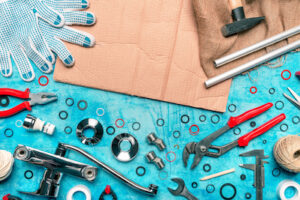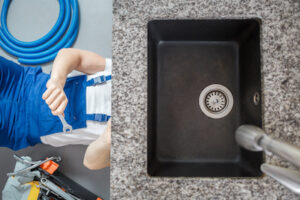Home Plumbing Service Guide: Common Plumbing Issues and How to Fix Them
Are you tired of dealing with leaky faucets, clogged drains, or faulty water heaters? Plumbing issues can be a major headache, but fear not! We’ll delve into plumbing services, focusing on common problems homeowners face and the best ways to fix them. From understanding the causes of low water pressure to unclogging stubborn drains, we’ve got you covered. So, if you want to save time, money, and the hassle of hiring a professional, read on to discover practical tips and tricks to tackle those pesky plumbing issues on your own.

Identifying Common Plumbing Issues
Maintaining a home’s functionality involves staying vigilant about potential plumbing problems. Common issues include:
- Dripping Faucets: This not only causes water wastage but can also escalate your water bills.
- Slow Draining Sinks: Often caused by blockages that limit water flow.
- Clogged Bath or Shower Drains: Usually due to hair or soap build-up.
- Clogged Toilets: Often a result of flushing unsuitable items.
- Running Toilets: Can waste up to 200 gallons of water a day.
- Low Water Pressure: Often a sign of pipe leakage or blockage.
- Leaky Pipes: If left unattended, these can cause severe water damage.
Each issue demands prompt attention to prevent further complications.
Simple DIY Fixes for Common Plumbing Issues
Addressing common plumbing issues in your home can be easier than you think with a few simple DIY fixes:
Leaky Faucets: Wasting Water and Money
A dripping faucet not only creates an irritating sound but can also lead to a significant waste of water over time. The constant dripping can also stain sinks and create mineral deposits. To fix this issue:
- Locate the Shut-Off Valve: Turn off the water supply to the faucet.
- Disassemble the Faucet: Carefully remove the faucet handle and replace the worn-out washer or cartridge.
- Reassemble and Test: Put the faucet back together and turn on the water supply to check for leaks.
Additionally, if you have leaky pipes, some temporary fixes include waterproof tape or a pipe clamp.
Clogged Drains: Restoring Smooth Flow
Clogged drains are a common household nuisance, often caused by a buildup of hair, soap scum, and other debris. Follow these steps to unclog a drain:
- Boiling Water: Start with pouring boiling water down the drain to dissolve grease and debris.
- Plunger: Use a plunger to create suction and dislodge the clog.
- DIY Drain Cleaner: Mix baking soda and vinegar, let it fizz, and then flush with hot water.
- Snake or Wire Hanger: If the clog persists, use a drain snake or a bent wire hanger to manually remove the blockage.
Running Toilets: Stop the Silent Water Wastage
A running toilet is not just an annoyance; it can lead to a spike in your water bill. The culprit is often a faulty flapper valve or a damaged float. Here’s what you can do:
- Check the Flapper: Open the toilet tank and inspect the flapper. Replace it if it’s damaged or not sealed properly.
- Adjust the Float: If the water level is too high, adjust the float mechanism to control the water level.
Additionally, if you have clogged toilets, most clogs can be resolved with a plunger. If that fails, a toilet auger can be used.
Low Water Pressure: Regaining the Flow
If your once-powerful shower has turned into a weak drizzle, low water pressure might be the issue. Potential causes and solutions include:
- Mineral Buildup: Removing and cleaning sediment buildup from the faucet can help. Also, you can replace clogged faucet aerators or showerheads.
- Pipe Issues: Check for leaks, corrosion, or blockages in the pipes. Consult a professional if needed.
- Pressure Regulator: Adjust the pressure regulator if it’s not set correctly.
Jammed Garbage Disposal: Restoring Functionality
A jammed garbage disposal can disrupt your kitchen routine. Before attempting to fix it, remember to turn off the power to the disposal unit. Follow these steps:
- Manual Turn: Insert an Allen wrench into the bottom of the disposal and turn it to dislodge the blockage.
- Reset Button: Look for the reset button under the unit and press it to reset the motor.
- Remove Foreign Objects: If the jam persists, use tongs to carefully remove any foreign objects.
Frozen Pipes: Preventing Burst Pipes
During cold winters, frozen pipes can lead to disastrous leaks and costly repairs. Here’s how to prevent and deal with frozen pipes:
- Insulation: Properly insulate exposed pipes with foam sleeves or heat tape.
- Drip Faucets: Allow faucets connected to vulnerable pipes to drip slightly to relieve pressure.
- Warm Air Circulation: Keep cabinets open to allow warm air to circulate around pipes.
Remember, some issues may require a professional plumber if they persist.
When to Call a Professional Plumber
While many minor plumbing issues can be solved with DIY fixes, it’s crucial to know when to call a professional. Situations requiring a plumber may include persistent leaks, low water pressure, severe blockages, and plumbing installation. If DIY solutions fail to resolve an issue, it could signify a more severe problem. Additionally, if you’re uncomfortable doing the work or the problem involves main sewer lines or water heater issues, it’s best to call a professional to avoid causing further damage.

Tips to Prevent Plumbing Issues
Preventive maintenance can spare homeowners from many plumbing issues. Here are some tips:
- Routine Checks: Regularly inspect for leaks, drips, and signs of pipe damage.
- Use Drains Appropriately: Avoid disposing of grease, hard food remnants, or non-degradable items down your drains.
- Install Strainers: Prevent hair or foreign objects from clogging your drains.
- Toilet Care: Only flush toilet paper to prevent clogs.
- Regulate Water Pressure: High pressure can damage your pipes.
By adopting these practices, you can ensure a long lifespan for your home’s plumbing system.
Frequently Asked Questions (FAQs)
Q: Can I fix a leaking faucet without any plumbing experience?
A: Yes, fixing a leaking faucet is relatively simple and doesn’t require advanced plumbing skills. Just follow the steps outlined in the guide.
Q: When should I call a professional plumber instead of fixing the issue myself?
A: If you encounter a plumbing problem that seems too complex or if you’re unsure about your ability to fix it, it’s best to call a professional plumber to avoid causing further damage.
Q: What can I do to prevent clogs in my drains?
A: To prevent clogs, use drain screens to catch hair and debris, avoid pouring grease down the drain, and periodically clean your drains with a mixture of baking soda and vinegar.
Q: How can I avoid frozen pipes during winter?
A: Insulate exposed pipes, allow faucets to drip during cold spells, and keep your home adequately heated to prevent pipes from freezing.
Q: Are there any eco-friendly solutions for unclogging drains?
A: Yes, you can use a combination of baking soda and vinegar to clear minor clogs without resorting to harsh chemical drain cleaners.
Q: Can I fix a running toilet by jiggling the handle?
A: While jiggling the handle might provide a temporary solution, it’s better to address the root cause by checking and fixing the flapper or float mechanism.
Conclusion
In conclusion, a plumbing service effectively addresses common issues like leaks, clogs, and low pressure. While DIY solutions can provide temporary fixes, professional intervention ensures long-lasting results. Understanding these common problems empowers homeowners to make informed decisions, reduce damage, save money, and maintain a healthy, well-functioning plumbing system.
